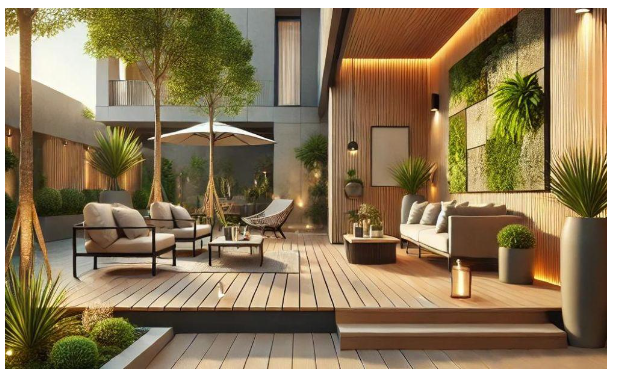Innovative Trends in Composite Decking for Outdoor Spaces: Market Insights and Design Developments
Composite decking has become a cornerstone of modern outdoor design, offering a combination of durability, low maintenance, and aesthetic appeal. As outdoor living spaces continue to evolve, the trends in composite decking also shift to meet the demands of homeowners and designers alike. This article explores the current and emerging trends in outdoor composite decking, providing insights into materials, design, functionality, and market preferences.
1. Innovations in Materials and Technology
- Development of New Composite Materials
The composite decking industry has seen the introduction of high-performance materials that enhance durability and longevity. These materials are engineered to withstand harsh weather conditions, resist moisture, and prevent mold and mildew growth. Advanced composite materials, such as capped composites, provide an additional protective layer that improves the deck’s resistance to stains, scratches, and fading.
There is a growing emphasis on using eco-friendly and sustainable materials in the production of composite decking. Many manufacturers are incorporating recycled content into their products, reducing the reliance on virgin materials and minimizing environmental impact. This shift towards sustainability aligns with consumer preferences for greener building options.
- Advancements in Manufacturing Technology
New manufacturing processes have significantly improved the quality and consistency of composite decking products. Techniques such as co-extrusion allow for the creation of decks with a strong core and a durable outer shell, enhancing performance and appearance.
The application of 3D printing and smart materials is opening new possibilities for customized decking solutions. These technologies enable precise manufacturing of intricate designs and features that were previously difficult to achieve, offering more options for personalization.
The advent of outdoor WPC (Wood Plastic Composite) decking has revolutionized the market by combining the best properties of wood and plastic, providing an eco-friendly and highly durable decking solution. Outdoor WPC decking is particularly valued for its resistance to splintering and warping, making it a safe and long-lasting choice for families.
2. Design and Aesthetic Trends
- Diverse Colors and Textures
A growing trend towards natural hues and wood-grain designs that mimic the appearance of traditional wood is evident. These designs offer the aesthetic appeal of natural wood without the associated maintenance challenges. Homeowners can choose from a wide range of colors, from rich earth tones to contemporary grays, allowing them to match their deck to their home’s exterior and landscape.
The rise of custom colors and unique textures enables personalized outdoor spaces. Textured finishes, such as embossed wood grain or brushed surfaces, add depth and character to decks, making them visually appealing and comfortable underfoot.
- Innovative Design Elements
The integration of embedded lighting and smart control systems is becoming increasingly popular. These features enhance the functionality and ambiance of outdoor spaces, allowing homeowners to enjoy their decks both day and night. LED lighting strips, solar-powered lights, and smart home integration are some of the innovations transforming deck designs.
Modular and transformable designs are gaining traction, offering flexibility in outdoor space utilization. Modular decking systems can be easily assembled, disassembled, and reconfigured, making them ideal for temporary setups or spaces that require frequent changes.
The integration of deck gardens within composite decking spaces is becoming increasingly popular, adding greenery and a touch of nature to urban and suburban settings. Deck gardens not only enhance the aesthetic appeal but also promote environmental benefits by supporting biodiversity and improving air quality.
3. Functionality and Multi-Purpose Use
- Designing for Multi-Functionality
Modern deck designs are increasingly incorporating multifunctional elements that combine entertainment, relaxation, and practical uses. Features such as built-in seating, outdoor kitchens, fire pits, and pergolas create versatile spaces that cater to various activities and gatherings.
Incorporating storage spaces and seating within the deck structure maximizes utility. Storage benches, under-deck storage solutions, and integrated planters are practical additions that enhance the functionality of the deck without compromising aesthetics.
- Sustainability and Eco-Friendly Features
The incorporation of rainwater harvesting systems and green roofs within deck designs reflects a commitment to sustainability. These features help manage stormwater runoff, reduce the heat island effect, and promote energy efficiency.
The use of recycled materials and low VOC (volatile organic compounds) products supports environmental sustainability. Decks made from recycled plastics and wood fibers reduce waste and lower the carbon footprint of construction projects.
Deck gardens are an excellent example of multifunctional outdoor spaces, blending aesthetics with utility and environmental benefits. They provide a serene space for relaxation while supporting local flora and fauna, contributing to a more sustainable living environment.
4. Market Demand and Consumer Preferences
- Demand for Low Maintenance and Long Lifespan
Consumers are increasingly prioritizing low maintenance and long lifespan in their decking choices. Composite decking meets these demands by offering surfaces that are easy to clean and maintain. Unlike traditional wood, composite decks do not require regular staining, sealing, or painting, saving homeowners time and effort.
Products that offer warranties and long-term performance assurances are highly sought after. Manufacturers are responding by providing extensive warranties that cover issues like fading, staining, and structural integrity, giving consumers peace of mind.
- Considerations for Safety and Comfort
Safety features, such as slip-resistant surfaces and UV-resistant properties, are crucial for families and high-traffic areas. Composite decking is designed to provide a safe walking surface, even when wet, reducing the risk of slips and falls.
Comfort is another key consideration in deck design. Composite decking materials are engineered to stay cooler underfoot compared to traditional wood, making them more comfortable to walk on during hot weather. Ergonomic designs that incorporate comfortable seating and shade structures enhance the overall user experience.
The preference for outdoor WPC decking is rising due to its low maintenance requirements and long-lasting performance, meeting the demands of modern consumers. Its ability to withstand various weather conditions without deteriorating makes it an attractive option for homeowners seeking both beauty and durability.
5. Case Studies and Success Stories
- Sharing Successful Projects
Examples of successful composite decking installations in various environments and uses provide valuable insights. Projects showcasing decks in residential backyards, urban rooftops, and commercial spaces highlight the versatility and adaptability of composite decking.
Highlighting consumer feedback and satisfaction with their composite decking choices helps potential buyers make informed decisions. Testimonials and reviews from homeowners who have successfully integrated composite decking into their outdoor spaces offer practical perspectives on product performance and benefits.
- Future Trends Outlook
The potential of emerging technologies and design innovations to shape the future of composite decking is immense. Developments in smart materials, augmented reality for design visualization, and sustainable production methods are set to revolutionize the industry.
Predicting future market demands and evolving consumer needs is essential for staying ahead in the composite decking market. Trends such as increased interest in eco-friendly products, the desire for unique and personalized designs, and the emphasis on multifunctional outdoor spaces are likely to continue shaping consumer preferences.
Deck gardens have shown remarkable success in various urban projects, showcasing the versatility and appeal of combining greenery with composite decking. These projects illustrate how integrating natural elements into outdoor living spaces can enhance both functionality and aesthetic appeal, providing a holistic approach to outdoor design.
Conclusion
Composite decking continues to advance, driven by innovations in materials and technology, evolving design trends, and growing consumer demand for sustainable, low-maintenance solutions. By staying informed about these trends, homeowners and designers can create beautiful, functional, and lasting outdoor spaces. The integration of outdoor WPC and deck gardens represents the future of composite decking, merging durability with environmental consciousness and aesthetic pleasure. For further insights and resources, explore professional websites and forums to stay updated on the latest in composite decking.


